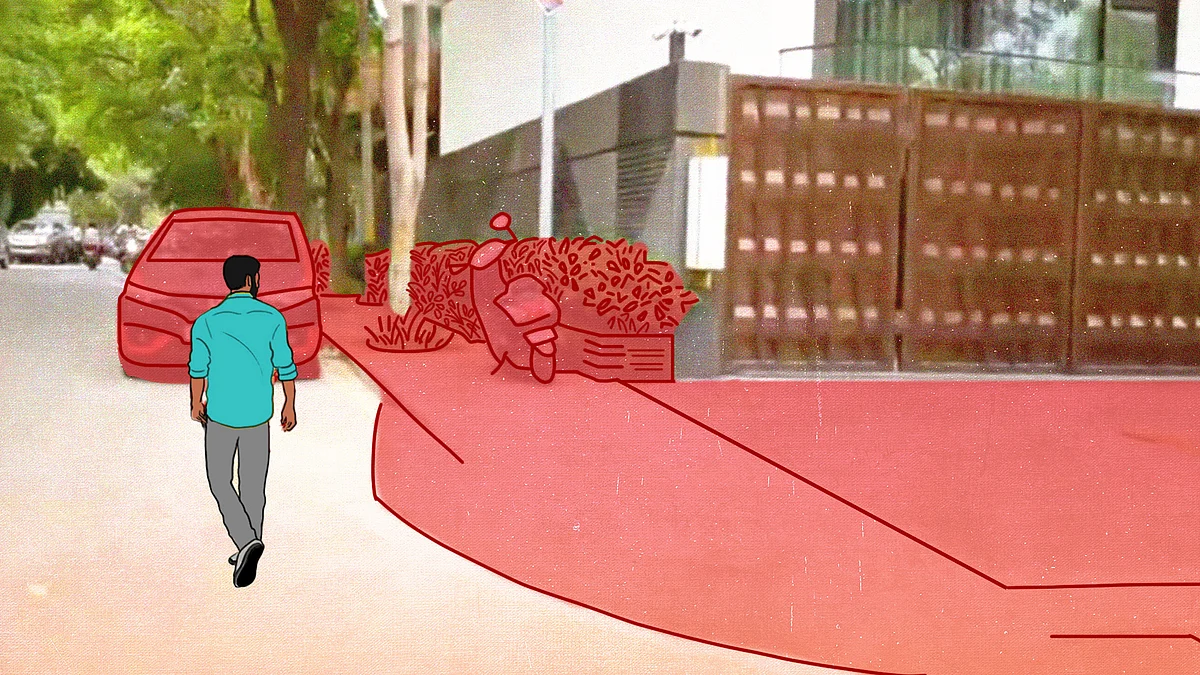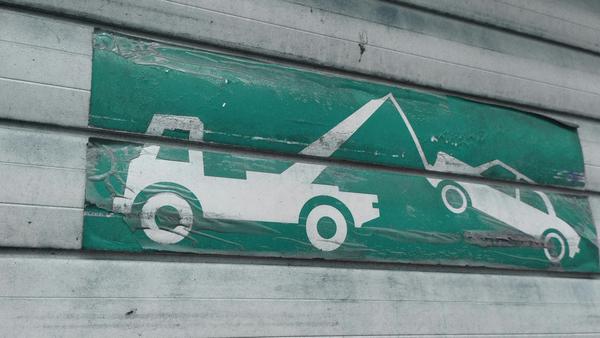
“There appears to be a concerted effort to regularise illegal constructions by the affluent.”
That’s what the Supreme Court said on May 3 while seeking the response of the central and Delhi governments and the capital’s civic authorities.
While the court was referring to the issue of regularisation of unauthorised constructions in select elite neighbourhoods, the problem runs wider.
A Newslaundry investigation, following a similar report from Defence Colony, has now found clear signs of encroachment in the South Delhi locales of Vasant Vihar and Shanti Niketan. Where footpaths meant for public use have been steadily gobbled up by driveways, potted plants, and private security booths.
This, in a city where over around 27,000 people, many from vulnerable backgrounds, have been displaced in demolition drives over unauthorised constructions in the last four months.
Vasant Vihar: 80% trees concretised
According to the Indian Road Congress guidelines, footpaths in residential areas are required to have three distinct zones, a frontage or dead zone, a clear pedestrian zone, and a furniture or multi‑functional zone, with the pedestrian zone alone being at least 1.8 meters wide. As per these guidelines, the walkability score of a road depends on “footpaths that are free of encroachments”, among other factors.
According to Devinder Kumar, one of the council members of the IRC, the guidelines apply to internal colony roads too – connected to a network of highways, arterial and sub-arterial roads in urban areas.
But stroll down Pashchimi Marg in Vasant Vihar and you’ll spot the Vasant Vihar Club – one of the only structures on that road with a usable footpath. Directly opposite the club stands an embassy building. In front of it: a security booth and a neat row of potted plants, planted not in private courtyards, but on public space meant for pedestrians.
Vasant Vihar, developed in the late 1960s as a cooperative housing society by retired central government officers, now boasts nearly 1,350 plots spread across Blocks A to F. Along with ex-bureaucrats, the colony houses doctors, diplomats, and celebrities.
But it seems respect for public space is scarce among these rich residents. Across the colony, footpaths have nearly vanished under makeshift driveways and private guardrooms. Of the 58 embassies located here, at least 10 encroached on footpaths – either with ramps, booths, or decorative obstructions.
Additionally, a 2020 tree census by residents found that 80 percent of trees in the colony had been concretised – choked by the surrounding pavement to create vehicle ramps or guard posts. In 2022, the Delhi High Court had criticised the MCD’s failure to act, calling its “soft pedalling” of the issue a form of silent encouragement to illegal encroachments.
Yet when the MCD attempted to demolish some ramps, the Vasant Vihar Residents’ Welfare Association appealed, seeking time to explore voluntary removal of illegal ramps in coordination with civic authorities. The High Court stayed the demolition pending further hearings. The case is still ongoing, with the next hearing scheduled for September.
Meanwhile, residents continue to modify public land. A house in D Block has built a driveway by paving over a tree pit. The homeowner explained: “Potted plants are much better to keep as they don’t interfere with the driveway when we wish to take the car inside the house. That is why we have made this driveway and what can we do if the tree was planted here.”
Gurpreet Bindra, president of the Residents’ Welfare Association, questioned the inconsistency: “If embassies are allowed guard booths, why not other residents?...There’s a previous high court order allowing embassies and high commissions to have security guard rooms outside.” Newslaundry could not independently verify the claim.
Newslaundry sent an email to the embassy in front of the Vasant Vihar Club mentioned earlier in this report. This report will be updated if they respond.
Urban ecologist and local resident Vallari Sheel points out the environmental toll: “Trees are also suffering because of the encroachments which are in the form of concretisation around the trees, guard houses and driveways.”
A high-powered committee report on decongesting Delhi recommended that encroachment of footpaths should be made a cognisable offence under the Municipal Act.
An MCD official in the Green Park zone told Newslaundry, “Parking or having driveways on public land is encroachment, but the authorities can take action only to an extent. It becomes difficult if they reconstruct again.”
Additionally, each house has used different materials for their ramps, in violation of guidelines by the Indian Roads Congress – the apex body of highway engineers aimed at road development – that recommend consistent surfacing to protect footpaths from vehicle wear.
The result: a checkerboard of broken cement, decorative tiles, concrete ramps, and blocked tree pits.
Shanti Niketan: Footpaths for the few
Just 10 minutes away, Shanti Niketan – once a modest post-retirement haven for government officers – has turned into a hub for business tycoons. Of its 216 plots, nearly 200 are now owned by top businessmen.
Yet the patterns are the same. Street 5, lined with roughly 20 houses, has almost no uninterrupted footpath. Instead, driveways extend into public land. Decorative potted plants line the edges, and guards sit at invisible booths, tucked neatly behind gates.

One resident said: “If we, as residents, don’t make the driveways then how are our cars supposed to enter the houses?” Another said the plants were for aesthetic purposes, carefully placed to “make the front of the house look beautiful.”
The central market in the colony does have some footpaths – but they’re broken, and interrupted at various points to allow vehicular access.
Newslaundry reached out to RWA president Jagdeep Singh Rikhy. This report will be updated if he responds.
Shrinking footpaths affect pedestrians.
Rumaila*, a domestic worker in Street 5, told Newslaundry she walks on the road because there’s little space on the footpath. “It gets risky when big cars come, especially at night,” she said. “If there was a footpath, of course I’d use it.”
According to the Delhi Crash Report 2023 by Delhi Traffic Police, the Vasant Vihar traffic circle, including both Vasant Vihar and Shanti Niketan, recorded 29 fatal and 102 non-fatal accidents in a year. Both Vasant Vihar and Shanti Niketan fall under the New Delhi range, where Delhi Traffic Police recently acknowledged before the National Green Tribunal at least seven severely damaged or encroached footpaths.

Asked about encroachments, Himani Jain, the municipal councillor for both Vasant Vihar and Shanti Niketan, told Newslaundry: “Of course, we try our best and we carry out drives to remove them.”
Newslaundry had filed an RTI seeking details from the MCD about complaints pertaining to encroachment in Vasant Vihar and Shanti Niketan. But a response from the south zone said “no such information is available”.
Newslaundry reached out to Assistant Public Information Officer (Southwest) Traffic Ved Prakash, DCP (Southwest) Surender Chaudhary and MCD South Additional Commissioner Jitender Yadav. This report will be updated if they respond.
*Name changed to protect identity.
Reports like these take time and resources. Help us tell more stories that are in public interest. Subscribe today.
Newslaundry is a reader-supported, ad-free, independent news outlet based out of New Delhi. Support their journalism, here.







